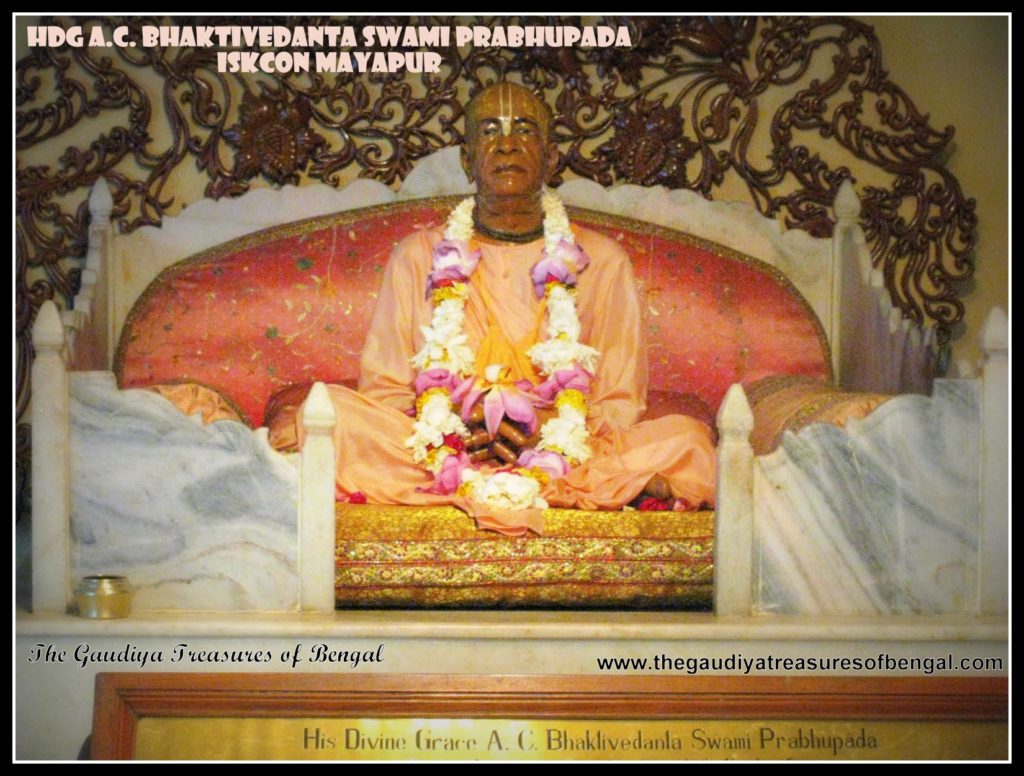
Sri Gour Mohan De and Srimati Rajani devi became the proud parents of Sri Abhay Caranaravrinda Bhaktivedanta Swami Prabhupada (Srila Prabhupada) on the 1st of September, 1896. A.C Bhaktivedanta Swami Prabhupada (1896 AD-1977 AD) or Abhay Carana, as he was previously called, was born on the auspicious occasion of Nandotsava, at the home of his maternal grandparents, in the suburbs of Tollygunge in Kolkata. The fortunate jackfruit tree under which he was born stands tall this day. Kolkata (erstwhile Calcutta) back then was the capital of British India and the ‘second city’ of the British Empire. The British and the Indians lived in separate parts of the city although they intermingled during work and business. The Indians lived more towards the north of the city while the British lived amongst their theatres, racetracks, and cricket fields in central Calcutta. Sri Gour Mohan De used to reside along with his family in his rented house at 151 Harrison Road (refer – ‘Srila Prabhupada’s pastime places in Central Kolkata’). He was a cloth merchant with moderate income and belonged to the aristocratic ‘Suvarna banik’ (gold merchant) community. We cannot help at this point but contemplate upon the exalted pastimes of another eternal associate of the Lord, Sri Uddharana Datta Thakura, who also belonged to this gold mercantile community (refer – ‘Sri Uddharana Datta Thakura Sripat, Adisaptagram’). Soon after Srila Prabhupada was born, an astrologer had prepared a horoscope for the child and made an accurate prediction. He prophesied that when Srila Prabhupada would reach the age of seventy, he would cross over the oceans, become a great preacher of religion and inaugurate 108 temples.
Srila Prabhupada – A timeline of his life and pastimes :
1896 – Birth
1918 – Marriage
1922 – Meets Srila Bhaktisiddhanta Saravati Thakura for the first time
1933 – Receives initiation
1944 – Publishes ‘Back to Godhead’ magazine
1947 – Receives title ‘Bhaktivedanta’
1959 – Awarded sannyasa
1965 – Arrives in America
1966 – Incorporates the International Society for Krishna consciousness (ISKCON)
1972 – Establishes the Bhaktivedanta Book Trust (BBT)
1977 – Departure from the material world
A.C Bhaktivedanta Swami Prabhupada – Childhood and school days :
Sri Gour Mohan De and Rajani devi, parents of Srila Prabhupada, were traditional Gaudiya Vaishnavas, who regularly invited saints to their house and requested them to bless their child. Just Opposite their home, across the street, stood the temple of Radha Govinda dev jiu, where Srila Prabhupada used to visit regularly. In one of his later conversations, Prabhupada identified Sri Radha Govinda jiu as the inspiration of his devotional life. The mesmerizing deity of Sri Radha Govinda dev jiu with their slanting eyes continue to enchant one and all with their blissful darsana till this day (refer – ‘Srila Prabhupada’s pastime places in Central Kolkata’). As a child, Srila Prabhupada used to pull his small deity carts and celebrate the Ratha-yatra festival, distributing prasadam to all the onlookers. His younger sister Bhavatarini was his assistant in all of his plays. Once when Srila Prabhupada swallowed a watermelon seed, his friends teased him by saying that it would grow into a watermelon fruit in his stomach. Prabhupada immediately ran to his mother, who consoled him by saying that she would chant the necessary mantras to ensure that nothing of that sort happened. When he grew up a little, he did not want to go to school. Rajani devi had to hire a person named Damodara for four rupees to forcibly carry Abhay to the nearby kindergarten school and ensure that he did not run away from there. There are innumerable childhood pastimes of Srila Prabhupada which we would have loved to narrate. But we are having to restrain ourselves considering the length of this article.
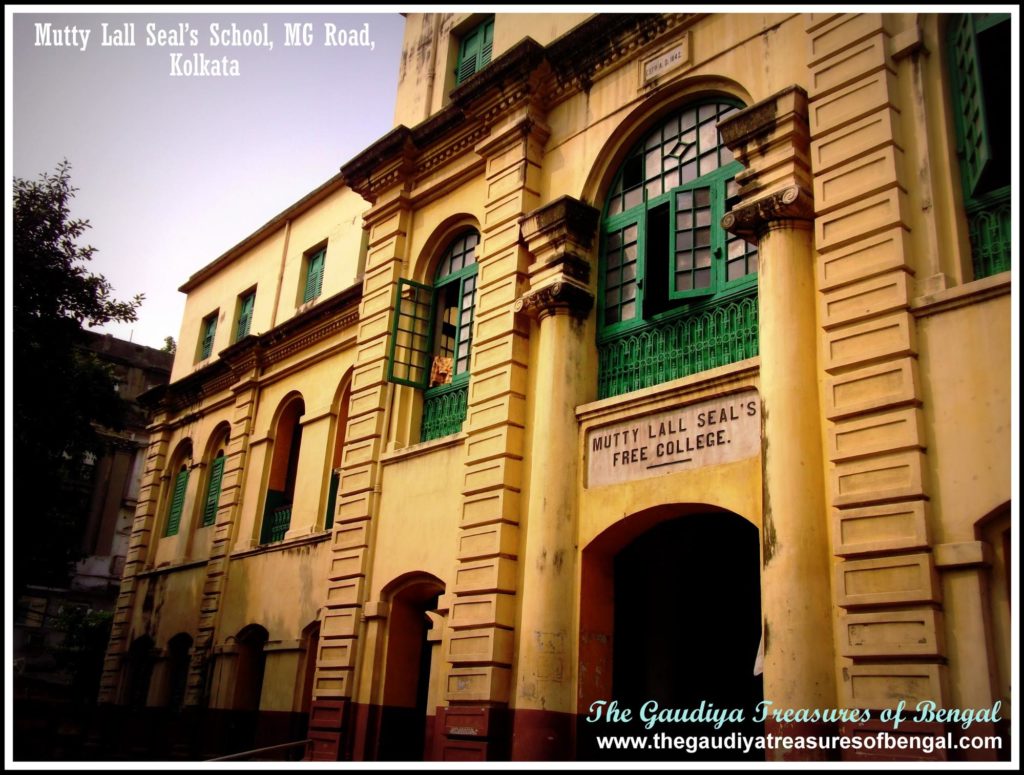
When Prabhupada turned eight, he was admitted into the nearby Mutty Lall Seal Free school. This school was established by a pious Suvarna vanik (gold mercantile) named Mutty Lall seal (refer – ‘Srila Prabhupada’s pastime places in Central Kolkata’). The school was situated a stone’s throw from Abhaya’s house at Govinda Bhavan. The teachers were Indian and the fellow students were mainly belonging to the ‘Suvarna vanik’ community. As he grew up, Abhay became an avid cyclist. He liked to ride his bicycle down the streets of Kolkata. A favorite route was to ride south towards the Dalhousie Square (near Raj Bhavan), sometimes going further down towards Maidan. He would generally return home riding along the bank of the Ganges. When Abhay was twelve, he was initiated by a professional Guru (spiritual master). It did not make much impression upon him, however, and he laid more stress on the devotional exercises that his father had taught him, like the worship of Radha-Krishna, observance of Rathayatra, etc. When Abhay was just sixteen years old, his mother Rajani devi passed away. This brought a sudden abrupt end to his tender childhood days, as he was now forced to grow up and prepare himself to take up worldly responsibilities. His father however gave him solace and instructed on how the soul is eternal and everything happens by Krishna’s sweet will. Gour Mohan Babu instructed Abhay to retain his faith and always depend upon Krishna.
A.C Bhaktivedanta Swami Prabhupada – College Days :
In the year 1916 (right after WW1), Abhay started going to college. Sri Gour Mohan De did not want his son to study in London and be exposed to the corruption of the west. He wanted his son to become a pure devotee of Lord Krishna. Yet, on the other hand, he did not want his son to become the Brahmacari (celibate) disciple of a Guru (spiritual master). ’Where is such a qualified Guru to be found ?’ he argued. Thus, Abhay got enrolled into the Scottish church college, one of the highly reputed colleges of Calcutta in those days (refer – ‘Srila Prabhupada’s pastime places in Central Kolkata’). This college was established in the year 1830 by Rev. Alexander Duff who was the first missionary to India from the church of Scotland. The Scottish Church is the second oldest college in North Calcutta and has produced numerous outstanding people, chief among them being A.C Bhaktivedanta Swami Prabhupada, Swami Vivekananda, and Netaji Subhas Chandra Bose (a contemporary of Srila Prabhupada).
Abhay studied Sanskrit and English in his first year, Sanskrit and philosophy in his second year, and philosophy and economics in his third. He was very close to his teachers and enjoyed a wonderful relationship with them. During his college days, under the direction of the famous Amritlal Bose, Abhay and his classmates once enacted a drama on the ‘Life of Lord Chaitanya’. Abhay played the role of Advaita Acharya. The audience was really moved by this performance and many in the audience were even seen crying. Abhay studied the works of western philosophers and scientists, yet they held no fascination for him.
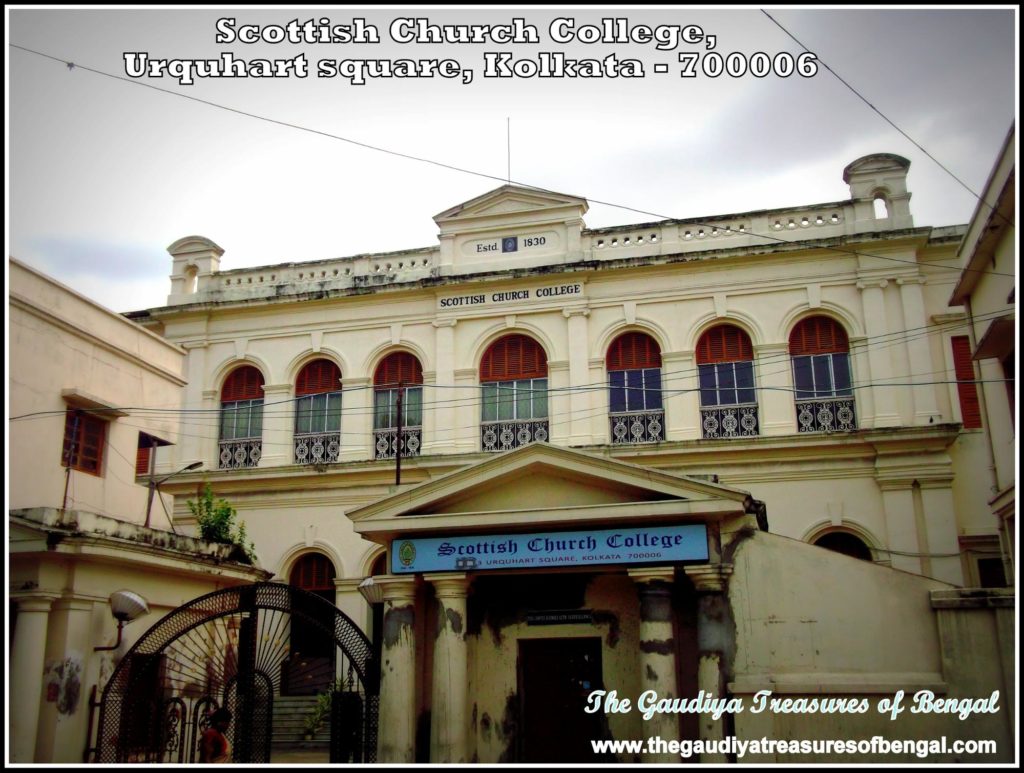
During his college days, Abhay was deeply moved by the Indian independence movement. He was influenced by the philosophy of Mahatma Gandhi, who always carried a Gita in his hands. Though Gandhi abstained himself from meat-eating, intoxication, and illicit sex, yet he was fully committed to the cause of nationalism. Abhay liked him and thought that Gandhi possessed more integrity than the sadhus he had seen begging. Gour Mohan De watched his son with concern. He concentrated on his son’s future and hoped that he grew up a pure devotee as the astrologer had predicted. Thinking thus, he decided to get Abhay married. Thus Radharani Datta, the daughter of a Suvarna vanik associated with the Mulliks, became Abhaya’s wife. Though the girl was beautiful, Abhay did not like her much and decided to get married for the second time. In those days, more than one marriage was acceptable in Indian society. But Sri Gour Mohan prevented his son. He explained to Abhaya, that it was only due to the mercy of Lord Krishna that Abhay was not that attached to his wife or family. It would subsequently help him in his spiritual advancement. Abhay listened to his father and refrained from marrying again. In due course of time, Abhay completed his graduation and obtained his B.A. degree. Though he was eligible to pursue a further diploma course in the Scottish church, Abhay rejected it. In this way, Abhay registered his protest against the British and responded to Gandhi’s call.
Srila Prabhupada – Working days begin :
Once Abhay passed out of his college, Sri Gour Mohan de arranged for his son’s job. He approached Dr. Kartick Bose, an intimate friend, and their family doctor. Dr. Kartick was a distinguished surgeon, a medical scholar, and a chemical industrialist. He had his own establishment, the Bose’s Laboratory, where he manufactured soaps, drugs, and other medicines. So Abhay was employed as his firm’s manager.
It was during these days, that Abhay, on the insistence of his friend Narendranath Mallik, first met with Srila Bhaktisiddhanta Sarasvati Thakura at his preaching center in Gauri Bari Lane (1, Ultadanga Main Road). At their very first meeting, Srila Bhaktisiddhanta Sarasvati urged Abhay to preach the message of Lord Chaitanya’s, all over the world. Abhay argued that India needed to gain her independence first before focussing on preaching her spiritual culture. Srila Bhaktisiddhanta replied how the Krishna consciousness movement was independent of any ruler or any man-made political system. He added that the movement of Lord Chaitanya was so exclusively important, that it could not wait. Abhay Carana, who was then a follower of Mahatma Gandhi, was deeply moved by the words of Srila Bhaktisiddhanta and remarked that the message of Lord Chaitanya was in the hands of a very expert personality. After their meeting, Abhay began to associate with the Gaudiya Math devotees and studied their books. The devotees told him more about Srila Bhaktisiddhanta and how he was the son of the famous Vaishnava Acharya, Srila Bhaktivinoda Thakura.
In 1921, Abhay and Radharani devi became the parents of their first son. As Abhaya’s attraction for Srila Bhaktisiddhanta Sarasvati grew, he considered himself unfortunate being unable to contribute much for his movement. He had a young wife and a son to look after. So he could not just leave his family responsibilities and join the mission full time. He had to find ways to serve being a householder. So he decided to start a new business. He thought that if he could gain some success as a businessman, he could contribute financially to further the mission of Srila Bhaktisiddhanta. So in 1923, Abhaya, along with his family, moved to Allahabad, to set up his new shop, Prayag Pharmacy. He partnered with a resident Bengali, Dr. Ghosh, who agreed to become a physician at this pharmacy. Dr. Ghosh would diagnose the patients and receive twenty-five percent from the sale of his prescriptions. Both Motilal Nehru and his son Jawaharlal were the customers at Abhaya’s pharmacy. As his business grew, Abhay had to travel extensively across India. In the year 1930, Sri Gour Mohan De passed away. It was a very painful loss for Abhay. Abhay had now lost someone who had given him everything and was careful to raise him as a devotee.
Abhay (Bhaktivedanta Swami) receives instructions :
In the year 1932, Srila Bhaktisiddhanta Sarasvati Thakura, led a procession of pilgrims ,on a month long parikrama, circumambulating the sacred places of Vrindavana. Srila Prabhupada caught up with his eternal spiritual master when the procession was stationed at Kosi, the site of Nanda Maharaja’s treasury. Here he received the opportunity to hear from Srila Bhaktisiddhanta. A few months later, the devotees at Allahabad informed Abhay of their plans to construct a new Gaudiya Math in the city. This new temple, Sri Rupa Gaudiya Math, was supposed to be soon inaugurated by Srila Bhaktisiddhanta Sarasvati. The funds and the land had already been secured. Along with inaugurating this new Gaudiya Math, Srila Bhaktisiddhanta was supposed to perform an initiation ceremony at Allahabad. Abhay intensely desired to receive initiation from him. So he approached the temple authorities, and expressed his desire to get initiated. When the devotees subsequently introduced Abhay to Srila Bhaktisiddhanta, he immediately recognized him and also remarked that Abhay was fond of hearing (Hari Katha) very well. He accepted him as his disciple and on the day of the initiation granted Abhay the Harinama as well as Brahmana initiations. He was awarded with the new name Abhay Caranaravinda. Abhay now began to consider how he could preach and assist his spiritual master in his mission.
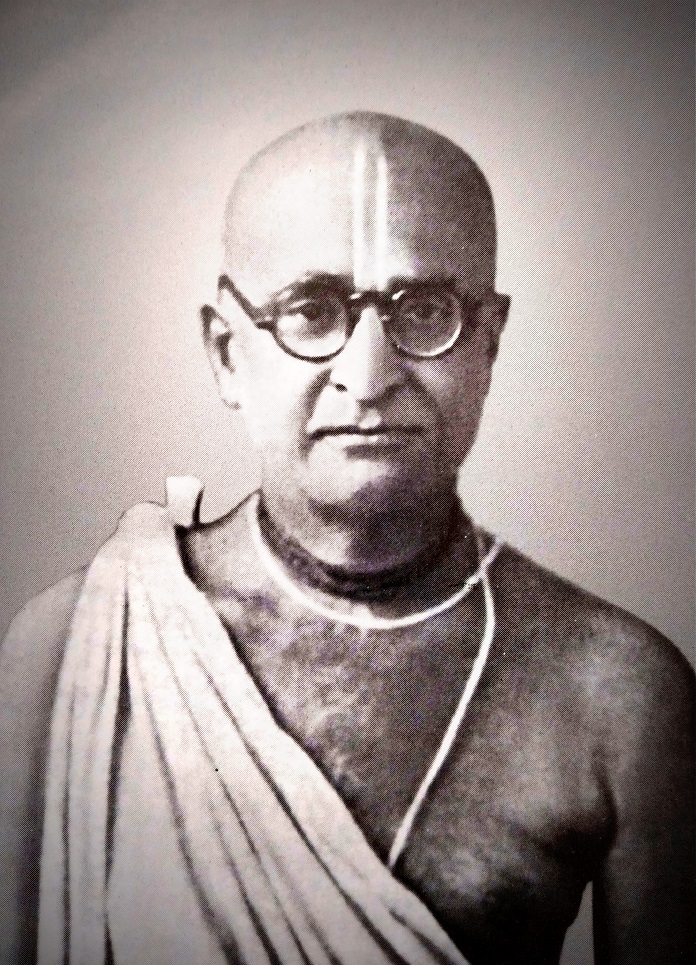
Prayag Pharmacy slowly fell into debt and it gradually developed a deep financial strain. As a result, Dr. Kartick Bose had to take over Prayag Pharmacy to absolve Abhay of his debts. Abhay now searched for a new job. He decided to move over to a major city like Bombay and set up his business there. While traveling around Bombay, he came across his godbrothers once again. They wanted to open a Gaudiya Math center in the city and requested Abhay for his help. Abhay happily consented and introduced them to his contacts. Spiritual life and assisting his Gurudeva was as much of a responsibility to him as maintaining his own family. Days passed by and Abhay was now well known within the inner circles of the Gaudiya Math. On one occasion, Abhay wrote a letter to his spiritual master seeking his instructions. He received a reply two weeks later asking him to preach in English the message of Lord Chaitanya. These were the exact instructions that he had received years ago when he met Srila Bhaktisiddhanta for the first time at Ultadanga. Now there was no more doubt to the purpose of his life and what his spiritual master wanted him to accomplish. Srila Bhaktisiddhanta Sarasvati Thakura passed away from this mortal world and entered the eternal pastimes of the Lord on the 1st of January, 1937.
The War :
As soon as Srila Bhaktisiddhanta left this world, quarrel began among his senior disciples as to who should get authority over the Gaudiya Math temples and perform all the initiations. The fight became so ugly that it even reached the courts. To make a long story short, this internal strife adversely impacted the preaching activities of the Gaudiya Math and ultimately broke it into several pieces.This is the worst that Srila Bhaktisiddhanta could have hoped for. Abhay was never too involved in the management affairs of the Gaudiya Math. He was more of a visitor (atleast externally) than a member of the Math.This worked in his favor and automatically put him at a distance from all the party politics that had then infested the atmosphere of Gaudiya Math.But he wanted to preach and serve his spiritual master’s orders.With his business diminishing in Bombay, Abhay relocated to kolkata along with his family. He rented a small house at 6 Sita Kanta Banerjee lane. The first floor of this building was his office where he operated a small chemical laboratory. His senior godbrother, Sridhara Maharaja, also rented a few rooms of this building from Abhay and opened a small ashrama, which he named as Devananda Sarasavati Math.Sridhara Maharaja had dissociated himself from the warring factions of the Gaudiya Math. Abhay often held discussions on Srimad Bhagavatam with Sridhara Maharaja.In the year 1939, Abhay wrote ‘Introduction to Gitopanishad’. The sannyasis residing there, were so happy with Abhaya’s writing that they conferred upon him the title Bhaktivedanta.
Soon the world war broke out. The British rulers created an artificial famine ,one of the worst ever in history.They tried to force people to join the army. They raised the prices of rice, dahl and the basic commodities, so as to create an artificial scarcity. As a result the people started dying in the streets of Bengal out of starvation. Calcutta was bombed during the war, and people began deserting the city.Prabhupada points out, that inspite of such severe injustice being meted out to them, the people of this country, being God conscious, did not revolt. Prabhupada however remained in Calcutta during the war, but he sent his sons to Navadvipa. In the midst of these calamities, Prabhupada as if felt the need, more than ever, to propagate Krishna consciousness. It was here at his residence at 6 Sita Kanta Banerjee Lane, that Srila Prabhupada began writing and printing his ‘Back to Godhead’ Magazine.

By 1945 the war was over. Abhay saw a dream one night in which Srila Bhaktisiddhanta asked him to accept sannyasa. He woke up in an intensely emotional state and wondered how he could afford to take sannyasa at that point of time. He had a family and business to look after. With renewed enthusiasm, Abhay started a new business, investing forty thousand rupees.This time, he opened a factory in Lucknow. He named his establishment ‘Abhay Charan De and sons’. Though neither his family nor his sons encouraged him, Srila Prabhupada continued to work with zeal. But Krishna had other plans. In 1948, he had to close his business as he had fallen behind in employees’ salaries and was by then paying the past rents in installments. He tried his luck with other factories in Lucknow and Allahabad, but they all failed. Krishna was forcing him into a helpless position and freeing him up for his preaching activities. His family members began abusing him for spending so much time thinking and discussing about God. Although Prabhupada tried his best to support his family, they misunderstood him.
Srila Prabhupada begins his Preaching :
There was a strong growing desire in Abhay to fulfill the desires of his spiritual master and preach the message of Lord Chaitanya across the world. The sequence of events that next took place helped him become determined. Abhaya’s wife Radharani was not too fond of his preaching spirit. Worse, she was addicted to drinking tea. She made a great mistake one day. There was a system of barter prevalent in those days, in which the shopkeeper would trade his goods for an equal weight of merchandise provided by the customer. As it happened, Radharani devi once traded Abhaya’s worshipable Srimad Bhagavatam (Bhagavata Purana) for purchasing tea biscuits. This shook Prabhupada. At first he felt very depressed but then resolved that he would have to leave his family to pursue his further goals in Krishna consciousness. He expressed his desire to leave home and dedicate his remaining life to preaching. His family did not take him seriously, and thought that he would be back soon.But he never came back.
Srila Prabhupada then tried his luck preaching in Jhansi where he formed a body named ‘League of Devotees’. He preached to a few localites who were very supportive initially. He even initiated a person named Prabhakar Mishra, who was a teacher. But then Prabhupada had no full time disciples at Jhansi and none of them were ready to fully surrender to the cause. When he tried to rent a house at Jhansi, he met with severe financial challenges and political pressure. He realized that Krishna had other plans for him. Blessing his students and wellwishers, he had to move on.

On being invited, he next began staying in Mathura at the ashramas (centers) of his godbrothers Keshava Maharaja and Bhakti Saranga Goswami Maharaja. Abhay was a well-known writer and his godbrothers wanted to utilize him for editing their magazines – Gaudiya Patrika and Sajjana Tosani (Hindi version of the Harmonist). Abhay thought that perhaps this was the service that Krishna had reserved for him. Initially, things went very well. He then traveled to Delhi where he needed to stay at the ashram of Bhakti Saranga Maharaja for his editorial purposes. There he found a disconcerting state of affairs. Neophyte brahmacharis, residing in the temple, fought amongst themselves. As a result, the preaching activities of the temple were in very bad shape. Worse, there was no typewriter and bad relations with the printer. Abhay continued to do his work amidst the chaos but he received no encouragement from his godbrothers. Abhay wanted to increase the number of copies of the magazines that were being printed and had grand plans to make the magazines compete with the best in the world. He even desired to translate Chaitanya Caritamrta in Hindi and distribute it to the Hindi-speaking population in Delhi, where he saw a demand. His lofty plans did not go down well with his godbrothers who were not that ambitious. They indirectly asked him to leave. So, Abhay was on his own once more.
Abhay did not give up. Though he did not have even a good pair of dhoti to wear, he could visualize a grand Krishna consciousness movement that would be instrumental in distributing the science of transcendental knowledge across the world. He had not published the ‘Back to Godhead’ magazine for four years now, and he wanted to resume it. But to print, he would require donors, and publishing even one issue of Back to Godhead Magazine seemed beyond his means. He used to write, edit, take them to the printer, then sell these magazines all by himself. Once while selling his magazines on the streets of Delhi, a stray cow charged him and knocked him down. At first, he could not get up and no one came to help him. On another occasion, he became a victim of the intense heat of Delhi. When a well wisher took him to a doctor, the doctor diagnosed him to be affected with heatstroke and advised him to take rest.
Abhay had desired to take shelter of Vrindavana for a long time. But he was not going to retire in Vrindavana. Instead, he decided to stay in Vrindavana, continue writing ‘Back to Godhead’, and deliver them to a printer in Delhi every fortnight. He rented a small room (5 rupees a month) at the top of the Vamsi Gopal jiu temple (near Kesi Ghat) from where he could view the entire Vrindavana. He knew the temple manager from his days at Jhansi. While Abhay was staying in Vrindavana, his disciple Sri Prabhakar Mishra caught up with him and introduced him to some religionists. Abhay thought that this might be his chance to preach. He was desperately searching for a forum. He traveled to Bombay to give seminars and tried to revive his ‘League of Devotees’. But the organizers were more interested in mundane interpretations of spiritual matters than actually appreciating the transcendental subjects. It did not work out.
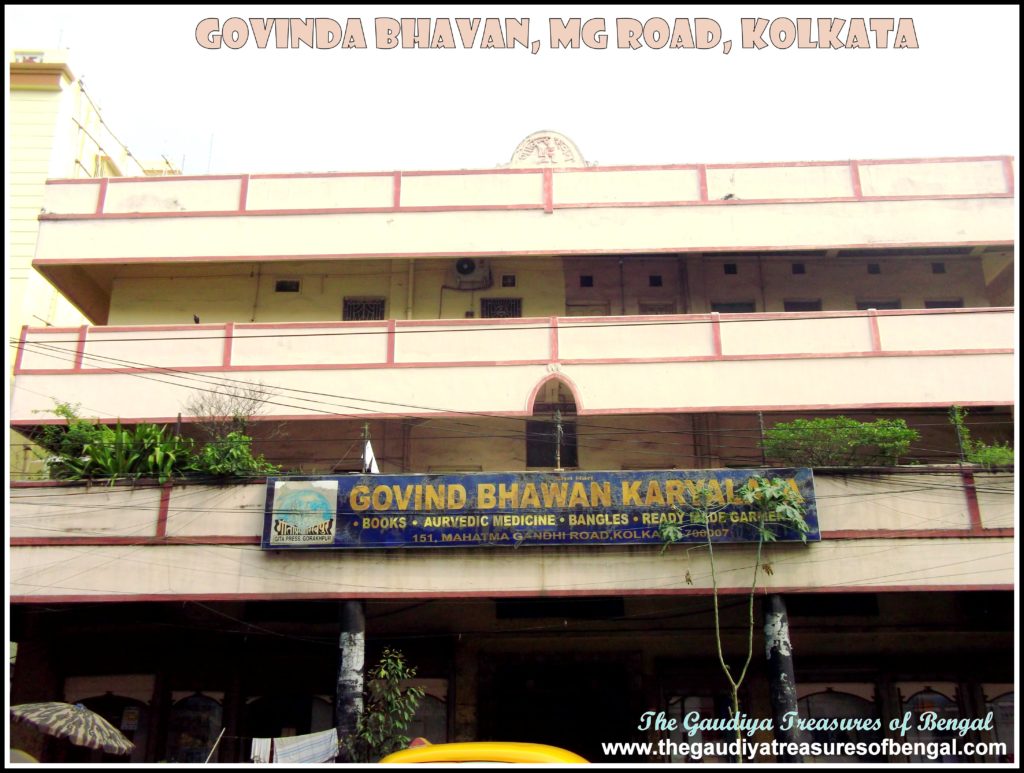
During one of these days, Abhay saw a dream in which his spiritual master urged him once again to accept sannyasa (renounced order of life). Now Abhay did not have the bindings of family life. Krishna had mercifully removed all the obstacles that stood in his way. Abhay considered and approached his godbrother Tirtha Maharaja (formerly Kunjavihari), the leader of Chaitanya Math in Mayapur and Calcutta, for his sannyasa initiation. He approached him first because Chaitanya Math had been the headquarters of his spiritual master’s mission. But Tirtha Maharaja, did not give him a very encouraging response. He asked Prabhupada to join first and then they will consider his request for sannyasa initiation and his desire to print the books. The books needed to be favorable to the service of the Chaitanya Gaudiya Math and everything depended on the funds that would be raised. Not receiving a favorable reply, Prabhupada then approached his godbrother Keshava Maharaja, who immediately accepted his request. Thus Prabhupada received his sannyasa initiation in 1959 at the Keshavji Gaudiya Math in Mathura. He gave up his white clothes forever. From Abhay Caranaravinda, he had then become Abhay Caranaravinda Bhaktivedanta Swami.
Prabhupada returned to Vrindavana and continued with his writing. Receiving an invitation from Gaurachand Goswami, the proprietor of the Radha Damodara temple, Srila Prabhupada shifted his residence from the Vamsi Gopala temple to a small room in the Radha Damodara jiu temple. He considered his new residence favorable for his writing as it was here that the exalted acharyas of our Brahma-Madhva Gaudiya sampradaya, (Sri Jiva Goswami, Rupa Goswami,etc) used to gather and discuss transcendental subjects. Prabhupada would seek blessings from their samadhis everyday. In addition to ‘Back to Godhead’, he now also began translating and commenting upon the Srimad Bhagavatam.
He obtained a wealthy donor in Mr Hanuman Prasad Poddar, a religious publisher from Gorakhpur, who was highly impressed with his commentary. He donated a sum of four thousand rupees. Thus the copies of Bhagavatam gradually began getting printed. As the printing work went on, Srila Prabhupada continued with his writing. When the proofs were ready, he would collect them, correct them and return to the press.After four months the whole book got printed and it was then sent for binding. Srila Prabhupada had to sell the copies of his books, collect the money and pay off his debt to the printer. In this way, he would receive further copies from the press. His Srimad Bhagavatam received highly positive reviews from eminent personalities like Dr. Radhakrishnan. His godbrothers also greatly appreciated his work.Prabhupada now wanted to go abroad and preach. Equipped with his books ,he felt that he was ready.
Travelling abroad :
It was forty years back, that Srila Bhaktisiddhanta Sarasvati had first asked Srila Prabhupada to go and preach in the west. He could not do so at that time due to his family responsibilities. That obstacle ,however, had long been removed and he was now free to travel abroad.He was sixty nine years of age and had to hurry. But he was practically penniless and for travelling to the west, he needed a sponsor, a passport, visa,p-form and above all ,the travel fare.He met a certain Mr. Agarwal who volunteered to get him a sponsor to America. His son Gopal, who lived in Pennsylvania during the time, did the necessary paperwork and soon the sponsorship was arranged. It did not take Prabhupada much effort to arrange for his passport either. He then approached Mrs Sumati Morarji and begged her for a ticket in one of her ships. Mrs Morarji initially refused because she was worried about the health of Srila Prabhupada. She doubted whether he would be able to make it through the journey and survive the cold weather of the USA. But Prabhupada was insistent. Finally, she relented and asked Prabhupada to get his p-form ready. A p-form is a certificate provided by the state bank of India stating that the particular individual has no excessive debts in India and is cleared by the banks. Prabhupada had no debts but he had no money either. The bank officials did not want to sanction him the certificate initially. They argued that Prabhupada was invited by a private person (not an institution) for a month. So after a month , Prabhupada could land up in grave difficulty. Seeing the officers not favorable, Prabhupada directly spoke to their superiors and somehow convinced them. Once the p-form was ready, it did not take him much time to get the visa. Mrs Morarji finally arranged a place for Prabhupada in one of her cargo ships, the ‘Jaladuta’, which was scheduled to set sail from Calcutta on August the 13th, 1965.
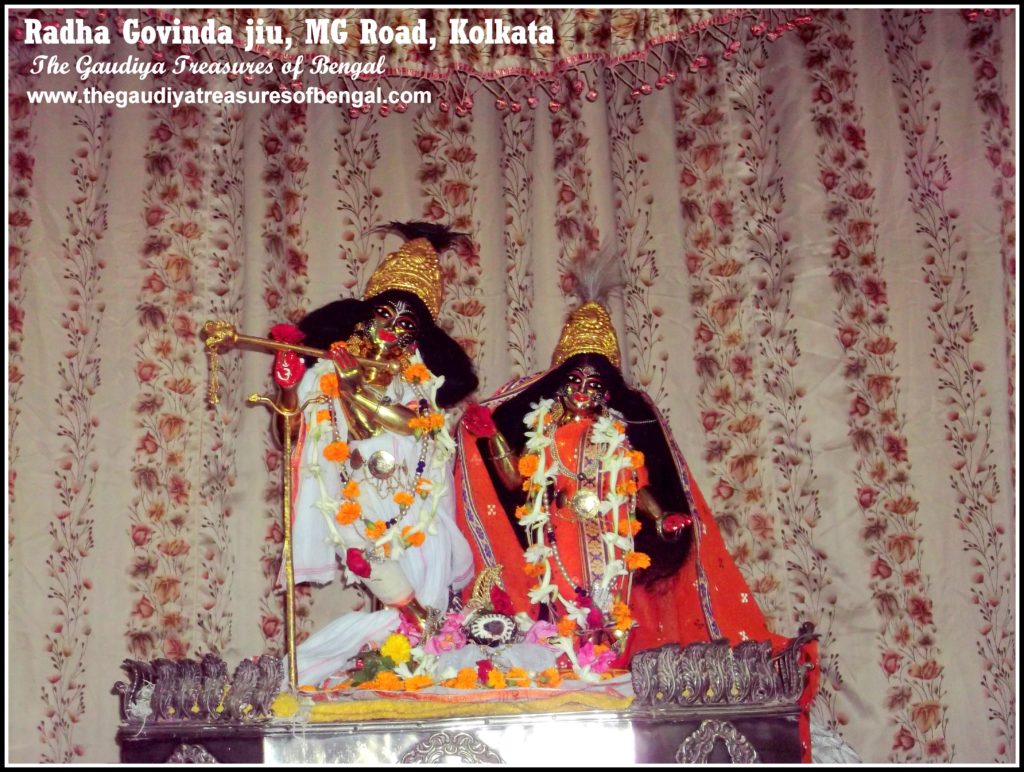
The day before his departure, Srila Prabhupada travelled to Mayapur to visit the samadhi of Srila Bhaktisiddhanta Sarasvati Thakura at the Chaitanya Math. ’The Gaudiya Treasures of Bengal’ has dedicated a separate article covering the significance and pastimes of this temple.The article is entitled – ‘Sri Chaitanya Math , Sri Chandrasekhar Acharya Bhavan (Masir Bari), Mayapur, Navadvipa’ . Srila Prabhupada boarded ‘Jaladuta’ the next day only with a suitcase, an umbrella and a supply of dry cereals. His main luggage consisted of several trunks of books that were being handled separately. There was no one on the shore to bid him goodbye – no friends, no supporter, no disciple. He was completely alone. Only Mr Sisir Bhattacharya, a friend whom he had met a year before at the Governor’s home in Lucknow, and Vrindavana Chandra, his son, were there to bid him goodbye. But Srila Prabhupada was very enthusiastic. Finally, by the mercy of his spiritual master, it was happening.
The thirty-five day journey was intense. Srila Prabhupada suffered greatly from seasickness, dizziness and vomiting. It got worse with the passage of time. In the course of his journey he suffered from two heart attacks. He prayed to Sri Krishna intensely. He understood that with one more heart attack, he could leave his body. Lord Krishna then appeared in his dream and he saw the Supreme Lord rowing his boat. He assured Prabhupada of His protection and asked him not to worry. The violent heart attacks did not recur. The Atlantic ocean became calmer than usual. In fact the captain admitted that he had never seen the Atlantic so calm in his entire life. Srila Prabhupada wrote in his diary that if the Atlantic had shown its usual face then perhaps he would have died in that ship. But Lord Krishna had taken charge and the calmness of the waters was His mercy.
Initial Days at the USA :
On nineteenth of September, the ship docked at the New York harbour. Srila Prabhupada spent the first few days at the house of Gopal Agarwala, his sponsor. He had a very good time, at Pennsylvania, acclimatizing with the American way of life. Sally Agarwal, Gopal’s wife and their little child Brij, grew very fond of Prabhupada, whom they referred to as Swamiji. After spending a month with them, Prabhupada left for New York. At New York, Srila Prabhupada put up at the residence of a certain Mr. Mishra who was a yoga teacher. They were diametrically opposite to each other philosophically. Mr Mishra was a Mayavadi. Anyways, these initial days helped Srila Prabhupada measure the needs of the American society and prepare him for his greater mission. In Spite of repeated requests he received no help from India – neither from any of his contacts nor his godbrothers. At the age of seventy, this old man was practically on his own in the streets of New York.
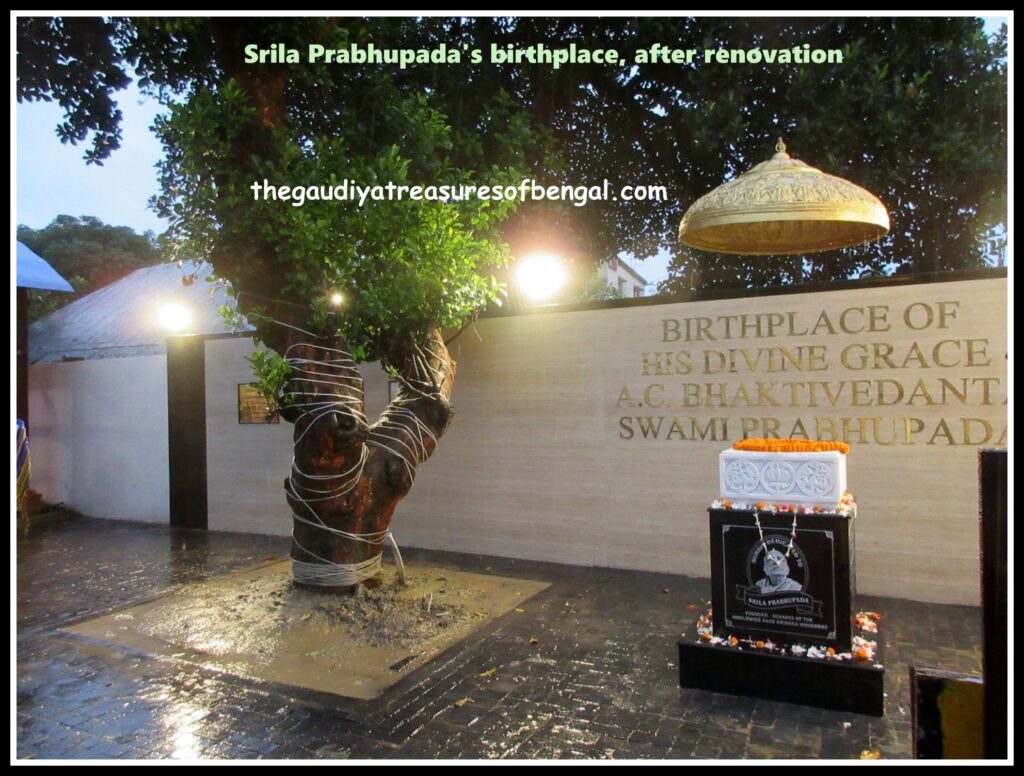
Prabhupada moved to his new residence, room no 307 in the same building. This was hardly a room to stay. It was more of a narrow office without furniture and telephone.He started his own classes over there and imparted lectures unto whoever was interested. But now he had to bear his own expenses. Mr Mishra no longer sustained him. His sole income was through selling his books. Things were going on and there were a few students who attended his classes. But then a theft occurred. The thief had stolen Prabhupada’s recorder and typewriter. On the advice of a few of his students, Prabhupada then shifted to the bowery. The bowery, during those days, was full of young people who had abandoned their homes in search of something higher. Most of them were addicted to drugs and it was a real challenge to preach amidst these crazy people (hippies). One of his students (David), being high on LSD, once attacked Prabhupada in a fit of violence.Prabhupada got alarmed. There was an utter lack of security. Hence he left the Bowery. He shifted to the residence of Carl Yeargens. But things turned from bad to worse. Here there was no one attacking him, but Eva, Carl’s wife, made Prabhupada feel very unwelcomed and uncomfortable. She was a feminist and could not accept the Swami’s way of life. She worried that Prabhupada’s principles and values would start to have an effect on her husband, who possessed a keen interest in Indian religions. Prabhupada’s well wishers concluded that it would be best for him to shift elsewhere. All of them, including Carl, helped him to find a small storefront at 26 second Avenue, which previously used to be a ‘Matchless Gift’ shop. They promised the Swami to help with his rents. These American people, no matter how crazy, were already taking part in Lord Chaitanya’s sankirtana movement.
How Srila Prabhupada founded ISKCON :
Here at the second avenue things gradually started looking up for Prabhupada. It was time. The rise of the hippies proved the ineffectiveness and the emptiness of the material civilization. Prabhupada had the universal solution.The weekly Bhagavad Gita classes began drawing more and more interested people. In the year 1966, taking the help of a local lawyer, Stephen Goldsmith, Prabhupada registered ISKCON ,’The International society for Krishna Consciousness’, as a nonprofit, tax exempt religious organization. Prabhupada could as if visualize temples, filled up with books and devotees. As if he already knew, that only time separated him from them.
Prabhupada held an initiation ceremony. The handful of followers he then had, took vows and accepted him as their spiritual master. Few days later he even arranged the marriage of two of his disciples, Mukunda (Mike) and Janaki (Jan), who loved each other. Prabhupada tried to align his surroundings as per the traditions of the Vedic culture. Without any help from India, or any of his Godbrothers, Prabhupada had now established a small temple, a registered society and a band of initiated disciples.

The devotees began distributing leaflets, advertising the chanting of the holy name. They organised sankirtana on the streets and the parks. The Swami promised the drug addicted youths that he could get them to “Stay High Forever”. Of Course the process was totally opposite to injecting artificial drugs and LSDs. Instead all they needed was to take up beads and chant the Hare Krishna Mahamantra (Hare Krishna Hare Krishna Krishna Krishna Hare Hare, Hare Rama Hare Rama Rama Rama Hare Hare). In the october of 1966, the devotees performed an ecstatic sankirtana at the Tompkins square park. They sang and danced for hours. The program was a great hit. The onlookers and the localites joined in the sankirtana, being attracted to its spiritual bliss. The New York Times printed the story the next day. It was the beginning of the ‘Hare Krishna Explosion’.
The movement expanded exponentially from this point. More and more American youths took up the teachings of Srila Prabhupada. Regular Book distribution became the norm of the day. Prabhupada would take classes, lead Kirtans, manage his society and continue with his writing staying awake through the night. There is a book called ‘Miracle on Second Avenue’ written by Mukunda Goswami (Prabhupada’s disciple) that encaptures how this Krishna consciousness movement unfolded in the west and how the causeless mercy of Chaitanya Mahaprabhu was freely distributed by Srila Prabhupada. Huge Rathayatra festivals were organised across the streets of the US, which attracted more and more American youth. During one of these Ratha Yatra festivals in San Francisco, our spiritual master, HH Jayapataka Swami Maharaja, was introduced to this Krishna consciousness movement. Gradually the Hare Krishna centers, as they were then known, were inaugurated across the USA. The movement spread across the seas, and the British Rock band, ‘The Beatles’, and its founders, especially Mr. George Harrison, were deeply moved by the teachings of Srila Prabhupada. ‘My Sweet Lord’, sung by Mr George Harrison, which he dedicated to the Supreme Lord Sri Krishna, topped the charts worldwide and became the biggest selling single of 1971 in the UK.
Considering the length of this article, we would like to now summarize the achievements of Srila Prabhupada in brief. By the time Srila Prabhupada passed away in 1977, he had already established 108 temples across six continents. He inaugurated the Rathayatra festival of Lord Jagannatha in major cities across the globe. He had initiated more than 5000 disciples and launched the ISKCON life membership program enrolling thousands of members. He encircled the globe fourteen times in these 10 years. He established major centers in Vrindavana, Bombay and Mayapur (refer- ‘Sri Mayapur Chandrodaya Temple – ISKCON, Mayapur , Navadvipa’). He established the ‘Bhaktivedanta Swami Charity Trust’ to unearth and renovate the holy places of Lord Chaitanya’s pastimes. He founded the BBT (Bhaktivedanta Book Trust) in 1972. He wrote approximately seventy books on the science of Krsna consciousness, sleeping only a few hours per day. Dozens of prominent scholars and educators from leading universities highly praised his work. In Chaitanya Mangala, Locana Das Thakura quotes Lord Chaitanya predicting that if the sinful people, giving up their religious principles, travelled to far off lands, His empowered commander in chief (senapati bhakta) , would go there in due time to deliver them as well. Srila Prabhupada was the commander in chief of Lord Chaitanya. Another of Lord Chaitanya’s prediction that in every town and village of this world, the chanting of His holy name would become heard, came to pass through the pastimes of Srila Prabhupada (prthibite ache yata nagaradi grama,sarvatra prachara haibe mora nama).
Videos: